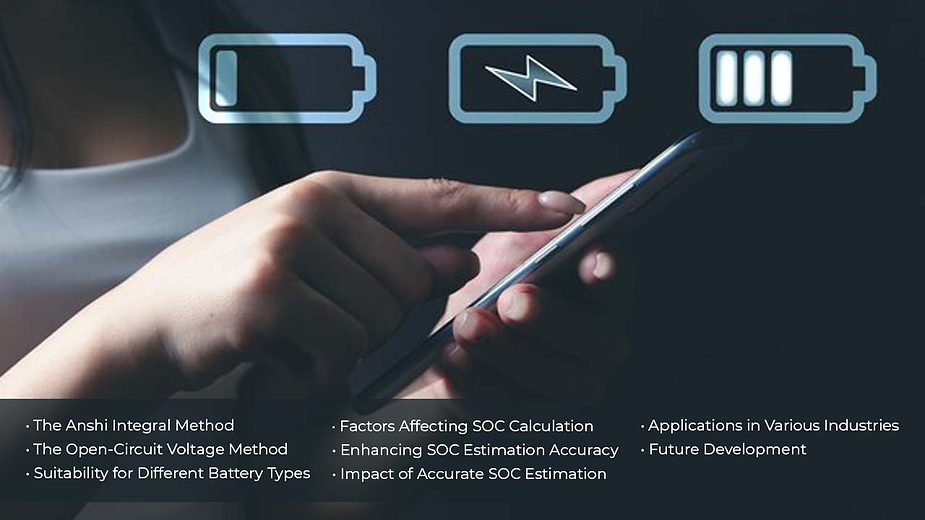In the dynamic world of dry goods batteries, accurately determining the State of charge estimation (SOC estimation for dry goods batteries) is crucial for optimal performance and longevity. This article explores two widely used methods for SOC estimation for dry goods batteries: the Anshi integral method and the open-circuit voltage method. By examining their mechanics, strengths, and limitations, we aim to understand each method’s suitability for different battery types clearly, highlighting recent advancements in SOC estimation.
I. The Anshi Integral Method:
The Anshi integral method precisely calculates SOC by considering critical variables such as charge and discharge currents, time, and total capacity. This method is a cornerstone of Precise SOC estimation technology and is versatile and suitable for various battery chemistries.

Operational Mechanics:-
- Current Measurement: Accurate measurements of charge and discharge currents using high-precision sensors are fundamental to SOC measurement for dry batteries.
- Time Integration: Integrating measured currents over time to determine the total charge transferred utilizes advanced SOC algorithms for batteries.
- SOC Calculation: Dividing the total charge transferred by the battery’s capacity to obtain SOC ensures Accurate SOC estimation methods.
Strengths
- Versatility: Applicable to different battery chemistries, enhancing Dry goods battery SOC improvement.
- Robustness: Resilient to noise and parameter variations, supporting reliable Battery state of charge monitoring.
- Accuracy: Provides precise SOC estimation when combined with other methods, contributing to Improving SOC estimation accuracy.
Limitations
- Sensor Dependence: Accuracy relies on the quality of current sensors, affecting the overall Battery management system SOC.
- Temperature Sensitivity: SOC calculation can be affected by temperature variations, necessitating adaptive measures.
- Computational Complexity: The integration process can be computationally expensive, impacting real-time applications.
II. The Open-Circuit Voltage Method
The open-circuit voltage method estimates SOC by measuring a battery’s voltage when no load is connected. This method is particularly effective for ternary and lithium manganate batteries due to their unique voltage characteristics, representing significant Innovations in battery SOC tracking.
Operational Mechanics:
- Voltage Measurement: Measuring the battery’s open-circuit voltage is a fundamental aspect of state-of-charge estimation techniques.
- SOC Lookup Table: Comparing the measured voltage to a pre-constructed lookup table utilizes Battery SOC prediction advancements.
- SOC Determination: Obtaining the corresponding SOC value from the lookup table ensures reliable Real-time SOC estimation for batteries.
Strengths:
- Simple Implementation: Requires minimal hardware and computational resources, making it an Accurate SOC estimation method.
- High Accuracy: Provides precise SOC estimates for specific battery chemistries, enhancing SOC measurement for dry batteries.
- Temperature Independence: Relatively unaffected by temperature variations, improving overall SOC estimation accuracy.
Limitations:
- Limited Applicability: Effective only for batteries with well-defined voltage-SOC relationships, restricting its use.
- Lookup Table Dependence: Accuracy depends on the quality and completeness of the lookup table, highlighting the need for comprehensive data.
- Dynamic Voltage Fluctuations: Self-discharge and other factors can affect open-circuit voltage accuracy, challenging State of charge estimation.
III. Suitability for Different Battery Types
The open-circuit voltage method is generally applicable, but its accuracy varies depending on the battery chemistry:
- Ternary Batteries: Highly suitable due to distinct voltage-SOC relationships.
- Lithium Manganate Batteries: Performs well due to stable voltage profiles.
- Lithium Iron Phosphate Batteries: Requires careful implementation and calibration for accurate estimation within specific SOC segments.
- Lead-Acid Batteries: Less suitable due to non-linear voltage-SOC relationships.
IV. Factors Affecting State of Charge Calculation
Several factors influence SOC estimation accuracy:
- Current Sensor Quality: Accuracy depends on high-precision sensors, critical for Battery state of charge monitoring.
- Temperature Variations: Battery capacity changes with temperature, affecting SOC calculation.
- Battery Aging: Aging reduces capacity and increases internal resistance, impacting SOC accuracy.
- Self-discharge: Natural discharge over time can lead to underestimation of SOC.
- Measurement Noise: Electrical noise in the system can introduce errors in SOC calculation.
V. Enhancing SOC Estimation Accuracy
To achieve accurate SOC estimation, several strategies can be employed:
- Fusion of Methods: Combining the Anshi integral method with the open-circuit voltage method improves accuracy by leveraging dynamic and static information, representing key Advancements in SOC estimation.
- Adaptive Algorithms: Real-time data-driven algorithms compensate for changing battery parameters and environmental conditions, enhancing SOC algorithms for batteries.
- Kalman Filtering: Advanced filtering techniques reduce measurement noise, enhancing accuracy and reliability.
VI. Impact of Accurate SOC Estimation
Accurate SOC estimation has significant implications across various applications:
- Optimized Battery Usage: Avoiding overcharging and deep discharging extends battery life and enhances performance, contributing to Dry goods battery SOC improvement.
- Improved Safety: Reliable information on remaining capacity prevents safety hazards associated with improper charging or discharging.
- Extended Battery Lifespan: Minimizing stress on batteries prolongs their lifespan, reducing costs and environmental impact.
- Efficient Battery Management: Accurate SOC information enables optimized charging, discharging, and prevention of premature failure, integral to the Battery management system SOC.
VII. Applications in Various Industries
Accurate SOC estimation finds applications beyond dry goods batteries:
- Renewable Energy Systems: Optimizes energy storage in solar and wind power installations.
- Electric Vehicles: Predicts driving range and optimizes battery performance, leveraging Battery SOC prediction advancements.
- Portable Electronics: Provides reliable information on remaining battery life in smartphones and laptops.
- Medical Devices: Ensures reliable operation of battery-powered medical devices for patient safety.
VIII. Future Development
Advancements in SOC estimation can be expected in the following areas:
- Advanced Machine Learning Techniques: Analysing data patterns for even greater accuracy.
- Battery Health Monitoring Integration: Comprehensive insights into battery performance and failure prediction.
- Wireless Communication: Real-time monitoring and remote battery management, enhancing Real-time SOC estimation for batteries.
Conclusion
Accurately estimating State of charge estimation is crucial for optimizing dry goods battery performance and lifespan. Understanding the mechanics, strengths, and limitations of the Anshi integral method and the open-circuit voltage method allows informed selection and implementation for different battery types. As technology progresses, further advancements in SOC estimation techniques will enhance the efficiency and reliability of dry goods batteries across diverse applications, driving forward Innovations in battery SOC tracking and Battery SOC prediction advancements.





